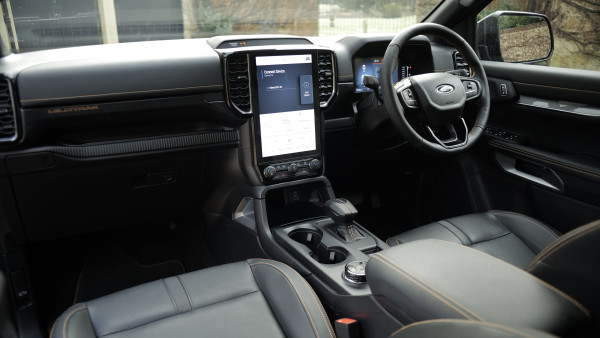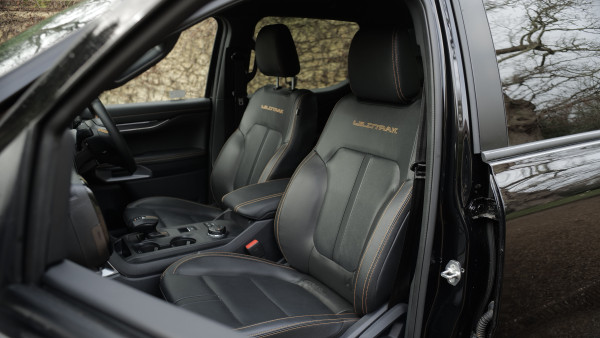












Images for illustration purposes only and may show options not included in the rental
Affordable Ford Ranger Diesel Diesel leasing, All our Ford Ranger Diesel leasing offers include free mainland delivery and exceptional customer support.
- Diesel
Personal (inc VAT)
Business (ex VAT)
Manufacturer OTR
0-62 MPH
Fuel Type
Transmission
CO2 Emission
Engine Power
Central (UK) Vehicle Leasing Limited are NOT liable for any manufacturer changes in models or specifications. It is the customers responsibility to ensure that the vehicle(s) has the correct specification required.
All Prices Subject to change and any offer may be removed from sale without prior
notice.
All offers are subject to availability
All images used are for illustration purposes only and may not reflect the
exact car supplied or model shown.
Specifications: Central (UK) Vehicle Leasing
Limited are NOT liable for any manufacturer changes in models or specifications. It is the
customers responsibility to ensure that the
vehicle(s) has the correct specification
required. Any information supplied on specification is only for
guidance purposes and
obtained from a third party CAP Data and not the manufacturer. For accurate specification
data please consult the manufacturer direct.
FROM
£431.99 inc VAT
Term: 24
Mileage: 6000
Diesel
Automatic
FROM
£411.53 inc VAT
Term: 60
Mileage: 5000
Diesel
Manual
FROM
£422.81 inc VAT
Term: 60
Mileage: 5000
Diesel
Manual
FROM
£438.73 inc VAT
Term: 60
Mileage: 5000
Diesel
Manual
FROM
£690.66 inc VAT
Term: 60
Mileage: 5000
Diesel
Automatic
Fed up with EVs? Ford offers an antidote with this gutsy fourth generation Ranger pick-up. Surf shack seekers should form an orderly queue, reckons Jonathan Crouch
Ford has re-invented its Ranger pick-up in this fourth generation form with extra attitude and an activity-orientated vibe that really suits it. It's more car-like where it counts - inside - but a proper pick-up in terms of cargo capacity, torque and traction. Want a truck? We think you'll want one of these.
Think of a pick-up and Ford is a name you just can't ignore, the company represented in this growing segment since the turn of the century by this tough, versatile Ranger model. This fourth generation design targets the growing lifestyle part of the pick-up market more directly than ever before, while still keeping the tough capability that will appeal to business operators. It's shares its design with the second generation Volkswagen Amarok, though Ford has led the engineering of this latest model; this is, after all, a key model for the Blue Oval brand - the Ranger accounts for nearly 40% of the European pick-up market. But it's very much a global product, designed and engineered in Australia, built in South Africa and Thailand and featuring a new 3.0-litre turbo diesel assembled in Dagenham, part of a design versatile enough for export to over 180 countries. Perfect in principle not only for core pick-up customers like farmers, plumbers and jobbing builders but also for the self-employed private people increasingly wanting a vehicle like this as a lifestyle accessory. Let's take a closer look.
The vast majority of Ranger customers will be choosing between Ford's offered range of proven Single-Turbo and Bi-Turbo 2.0-litre in-line four cylinder diesels. The Single-Turbo 170PS unit is the engine you'll need if you want manual transmission or the single cab body style with your Ranger. You're more likely though, to want the Bi-Turbo powerplant we tried, which puts out 205PS and can only be had with a 10-speed auto. The faster alternative is a 3.0-litre diesel V6 with 240PS, which also uses the 10-speed auto. You can also ask your dealer about a PHEV version, which combines a 2.3-litre EcoBoost petrol engine with an electric motor and a rechargeable battery system. When fully charged, a (rather unremarkable) EV range of up to 28 miles is promised. The top Raptor performance model uses a 3.0-litre EcoBoost V6 petrol unit with 292PS, but can also be ordered with the previous generation model's 210PS 2.0-litre diesel. For mainstream Rangers, Ford has developed a couple of four-wheel drive systems - a basic electronic shift-on-the-fly system for more affordable Ranger models. Or the more advanced full-time four-wheel drive system with a set-and-forget mode for the top automatic variants, including the volume 'Wildtrack' version we tried. Avoid base 'XL' trim and you get some basic drive modes - 'Normal', 'Eco', 'Slippery' and a 'Tow/Haul' setting you'll need to maximise the 3,500kg braked towing capacity that most variants offer. The more advanced full-time e-4WD system we tried adds a 'Terrain Management System' which on the 'Wildtrak' model is controlled by a rotary dial between the seats: a twist of this and you've access to a couple of extra modes - 'Mud/Ruts' (which maximises drive-off grip and keeps the tyre tread clear of mud) and 'Sand' (which optimises power delivery and gearshifting to maintain momentum in sand and snow). In the centre of the dial are your main drivetrain buttons - '2H', '4H', low range '4L' and the 'set-and-forget' '4A' auto 4WD setting. Across the line-up, pick-up regulars will immediately note after the first half mile that the steering isn't as slow as it usually would be in a truck; and that body roll is better controlled than it normally would be in a vehicle of this type. The ride's a bit better this time round too, thanks to the way that the rear suspension dampers have been shifted outboard of the frame rails. Ford, it seems, still knows a thing or two about R&D dynamics.
This fourth generation Ranger gets a bluff American vibe that customers will like, styling cues borrowed from the brand's US market Bronco SUV and F-150 large pick-up. And bulk quite intimidating enough to frighten away fast lane dawdlers. The broader stance helps too - it's 50mm wider. And there's a bigger radiator grille with a horizontal bar emblazoned with the Ford badge and extending into the eye-catching 'C-clamp' daytime running lamps. LED lights are available at both ends for the first time, the profile features more pronounced wheel arches and the tailgate design has the Ranger name embossed into the metal. As before, the line-up primarily built around a double cab body style. The Raptor version gets a bespoke grille and specially flared wheel arches housing 17-inch alloy wheels shod with chunky all-terrain tyres. Inside across the Ranger line-up, as you'd expect, it's much more car-like, with more up-market soft touch materials and a fully digital 12.4-inch instrument cluster that adapts its display around the six available driving modes. The centre infotainment monitor is bigger too - 10 or 12-inches, depending on spec. This display has a dedicated screen view for off-roading, providing information on steering angle, vehicle pitch, driveline and roll angles. The gearstick's been changed for a short-throw 'e-shifter': and there's now an electronic parking brake too. The Raptor model features 'jet fighter-inspired' seats, orange trim accents and stitching and paddle shifters fashioned from magnesium.
Trim levels start with 'XL', then 'XLT', 'Tremor', 'Wildtrack', 'Wildtrack X' and 'Platinum', with the high performance 'Raptor' model at the top of the line-up. Prices start from around £28,000 excluding VAT. Most will want one of the two doublecab 'Wildtrack' variants, one with the 205PS 2.0-litre EcoBlue diesel costing just over £40,000 ex VAT; and another doubecab 'Wildtrack' model with the new 3.0-litre V6 EcoBlue 240PS unit, costing around £45,000 (ex VAT). There's also a plush 'Platinum' version with a 240PS 3.0-litre V6 turbodiesel, costing from around £46,000 (ex VAT). Of course the top 'Raptor' variant is vastly more expensive; Ford has priced the twin turbo 3.0 V6 EcoBoost petrol version at around £60,000 (or around £56,000 in EcoBlue 210PS diesel form). Across the Ranger line-up, higher tech features are standard or can be added in. Ranger customers can now specify Matrix LED headlights and the included Wi-Fi allows for over-the-air updates. Lesser variants can also add in an optional digital dial pack for the instrument binnacle. Over hundred and 50 accessories are available stop. The top 'Raptor' features a 'Splash Decal Pack' and an exterior 'Raptor Pack', which includes a cab roll-over bar and power roll-top tonneau cover. You can also have your 'Raptor' with bright 'New Code Orange' premium paint. Customers can create their Ranger using the brand's online configurator, choosing from a wide range of colours; on the Raptor, these include 'Arctic White', 'Blue Lightning' and 'Code Orange'. Plus there's a Raptor Exterior Dress-Up pack and a 'Splash Decal' package. All Rangers can be specified with functional load bars and roller shutters.
Existing Ranger owners should find this version more practical than its predecessor. Thanks to the 50mm increase in track, the cargo area will now take a full-sized pallet and you can load in a ply sheet flat. There are slots moulded into the bed liner which allow you to make your own load dividers. And Ford continues to offer its 'Cargo Management' system. Removable protective capping prevents excess damage to the tailgate when lifting bikes in and out. There are some clever touches too. Dual-battery capability allows owners to add a leisure battery under the bonnet for camping trips - and for power tools, which can be connected via a 400w inverter with an AC outlet in the load bed. And there's a neat Zone Lighting System that allows you to turn on individual exterior lights for night activities. The tailgate can be converted into a workbench which has a built in ruler and onto which there's a facility for clamping planks of wood. The diesel engines offered here show no sign of efficiency gains through any sort of electrification, which is a little disappointing given that this model's Toyota Hilux arch-rival is already available with a 48V mild hybrid system and in future may be offered with hydrogen power. Still, this Ranger's stats are reasonably class-competitive in terms of economy and emissions. In the mainstream line-up, the figures range from 33.6mpg on the combined cycle and up to 220g/km of CO2 (that's for an XLT-spec manual 2.0-litre 170PS model); right up to 27.2mpg and 264g/km of CO2 (that's for the 3.0-litre V6 diesel with 'Wildtrak X' trim). We've been averaging about 30mpg during this test; you'd be closer to 25mpg in regular day-to-day use with the V6 diesel. Strangely, across the line-up, engine stop-start technology is only standard from high-up 'Wildtrack X' trim upwards; it ought to be standard on all models. Predictably, you'll need to pay for your pleasures with the top performance Raptor model. In 3.0 V6 EcoBoost petrol form, combined economy is 20.5mpg and CO2 emissions are up at 315g/km.
You can't deny that this fourth generation Ranger is a thoroughly engineered product. But is it the first Ford pick-up to truly approach market leadership? We think it might be. It's safe, spacious, clever, able to carry large loads and has engines that get the job done. Whether the need is for active family weekends, or simply to carry workmates with their kit and tools, this rugged do-almost-anything automotive swiss army knife seems to have it covered. From the back streets of Bangkok to the logging trails of Liberia, you'll find Rangers earning their keep, but the step forward here isn't really a rugged one: this Ford was always tough to break. It's in packaging, design and aesthetics. True, maybe the cabin isn't as car-like as the Blue Oval would like us to think, but it's a big step forward for a vehicle of this kind, aided by technology that'll see Japanese competitors having to play catch-up. When it all comes down to it, the right tool can make child's play of men's work. And if you're looking for the best all-round contender in the pick-up sector right now, then this is the right tool. Job done.